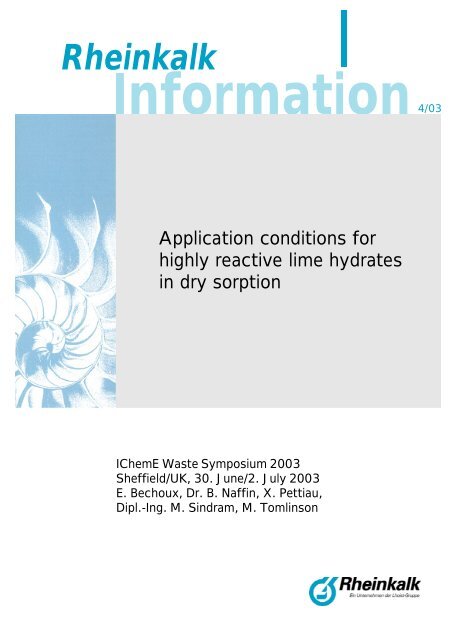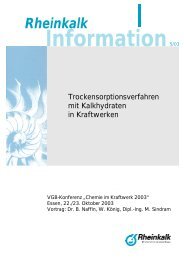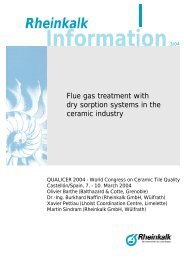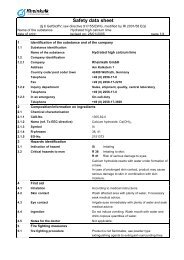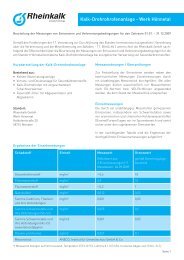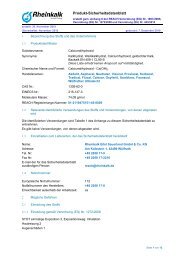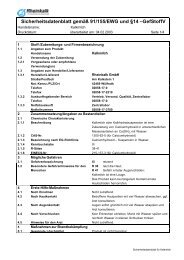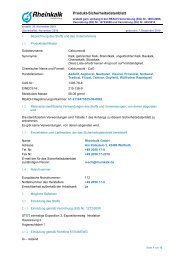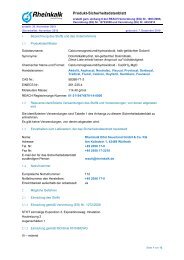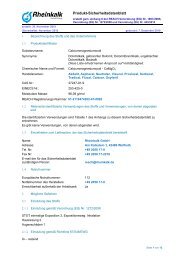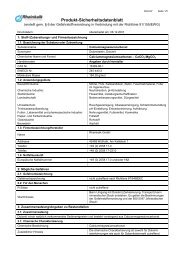SO - Rheinkalk
SO - Rheinkalk
SO - Rheinkalk
You also want an ePaper? Increase the reach of your titles
YUMPU automatically turns print PDFs into web optimized ePapers that Google loves.
<strong>Rheinkalk</strong><br />
Information<br />
Application conditions for<br />
highly reactive lime hydrates<br />
in dry sorption<br />
IChemE Waste Symposium 2003<br />
Sheffield/UK, 30. June/2. July 2003<br />
E. Bechoux, Dr. B. Naffin, X. Pettiau,<br />
Dipl.-Ing. M. Sindram, M. Tomlinson<br />
4/03
Eugene Bechoux; Lhoist Western Business Unit, Wavre; Belgium<br />
Dr. Burkhard Naffin; <strong>Rheinkalk</strong>, Wülfrath, Germany (Speaker)<br />
Xavier Pettiau; Lhoist Coordination Centre, Limelette, Belgium<br />
Martin Sindram; <strong>Rheinkalk</strong> GmbH, Wülfrath; Germany<br />
Mark Tomlinson, Lhoist UK, Hindlow, United Kingdom<br />
"Application conditions for highly reactive lime hydrates in dry sorption"<br />
Flue-gas treatment (FGT) processes can be roughly classified into three categories:<br />
1. wet flue-gas cleaning processes,<br />
2. semi-dry flue-gas cleaning processes,<br />
3. dry flue-gas cleaning processes.<br />
Wet FGT processes are primarily used in power stations for flue-gas desulphurisation<br />
(FGD). Because of the process technology the flue gas temperatures of approx. 60 -<br />
70°C in the scrubbing stage is achieved. In the case of semi-dry processes, a lime<br />
milk suspension is introduced into the stream of flue gas so that the flue gas is<br />
cooled by evaporation of the water to a temperature of 140 – 170 °C. The reaction<br />
products are separated as a dry powder by a downstream filter. In the case of dry<br />
processes, the reaction material is introduced as a powder into the flue gas. The high<br />
(850 – 1000 °C), medium (300 – 450 °C) and low (80 – 220 °C) temperature ranges<br />
are used for this (in particular for flue gas treatment of waste incineration plants). Dry<br />
processes have become standard in modern flue-gas cleaning since they offer the<br />
user decisive advantages.<br />
The common factor in all processes is the general use of lime-based products (milled<br />
limestone - CaCO3, lime - CaO, hydrated lime – Ca(OH)2) to neutralise the acid<br />
forming pollutants (HCl, <strong>SO</strong>2, HF). Criteria for the application of these products to<br />
scrub gases are, in addition to chemical purity (CaO content and secondary<br />
components), for<br />
· milled limestone: reactivity and grain-size distribution,<br />
· lime: hydrating behaviour (t60 value, dispersibility),<br />
· hydrated lime: grain-size distribution, specific surface area, pore volume.<br />
From the chemical point of view, hydrated lime is generally used for dry and semi-dry<br />
processes.<br />
The Lhoist Group has been a driving force since the mid-1980s in the development of<br />
products for use in semi-dry and dry processes (WÜLFRAsorp ® , WÜLFRAgran ® ), in<br />
particular. The result of this intensive research was the first hydrated lime with a high<br />
surface area, namely WÜLFRAsorp ® A. While standard hydrated lime usually has a<br />
specific surface area of approx. 18 m 2 /g (according to BET), the specific surface area<br />
of WÜLFRAsorp ® A is approx. 38 m 2 /g. In this way, the surface area available for the<br />
gas-solid reactions in the dry sorption process is, in principle, more than doubled.<br />
Furthermore, the number of particles and dispersibility is markedly increased owing<br />
to the fineness of the product (d50 approx. 3 µm compared to 6 µm for standard<br />
commercial hydrated lime). The intensive development to improve the standard<br />
1
hydrated lime by the Lhoist research department led to the product Spongiacal ®<br />
(brand name in Germany: WÜLFRAsorp ® D SP and in France Captacal ® SP). Here,<br />
in addition to a further increase in the specific surface area to approx. 45 m 2 /g, the<br />
pore volume, which is particularly important for the difficult removal of <strong>SO</strong>2, was<br />
decisively increased. While standard hydrated lime has a pore volume of approx.<br />
0.08 cm 3 /g, the corresponding value for Spongiacal ® is greater than 0.2 cm 3 /g (N2<br />
desorption).<br />
Particle Size d 50<br />
[10 -6 m]<br />
8<br />
6<br />
4<br />
2<br />
0<br />
Normal Hydrated Lime WÜLFRAsorp® A Spongiacal®<br />
Graph 1: Comparison of different Hydrated Limes<br />
Specific Surface Area [m²/g] BET<br />
50<br />
45<br />
40<br />
35<br />
30<br />
25<br />
20<br />
15<br />
10<br />
5<br />
0<br />
Normal hydrated lime WÜLFRAsorp ® A Spongiacal ®<br />
Graph 2: History of Development<br />
Porevolume [cm³/g]<br />
0,25<br />
0,2<br />
0,15<br />
0,1<br />
0,05<br />
0<br />
2
Dry processes have become standard in modern flue-gas cleaning since they offer<br />
the user decisive advantages. In addition to the safe compliance with mandatory<br />
limiting values and high flexibility, they also lead to lower investment and operating<br />
costs, low personnel expenditures as well as a simple concept and space-saving<br />
design. The reaction products are produced in the dry state. Examples for its use can<br />
be found in almost all fields of application, e.g.:<br />
• wood and biomass-fired power stations,<br />
• municipal waste incineration plants,<br />
• hazardous waste incineration plants,<br />
• conventional power stations,<br />
• non-ferrous metal processing,<br />
• glassworks,<br />
• ceramics industry,<br />
• process firing.<br />
In addition to the reduction of acid-forming pollutants, the removal of ecotoxic<br />
substances, such as heavy metals (e.g. Hg, Pb, Zn) and dioxins/furans<br />
(PCDD/PCDF), is of particular interest. These adsorption processes are carried out<br />
advantageously in the low-temperature range using suitable mixed products. For this<br />
application, the Lhoist Group can supply products tailored to the customer's<br />
requirements and which are based on Spongiacal ® , hydrated lime and limestone<br />
powder. The adsorption materials used are, for example, lignite coke and activated<br />
carbon. The products offered by Lhoist for this purpose offer a higher inherent safety.<br />
They can be used, if necessary, without additional apparatus and personnel<br />
expenditures. This fulfils the demand for more simple and more reliable plant<br />
engineering.<br />
specific surface (BET) [m²/g]<br />
60<br />
50<br />
40<br />
30<br />
20<br />
10<br />
0<br />
Normal hydrated lime Spongiacal® Hydrated lime<br />
with 3% lignite coke<br />
Graph 3: Lime Carbon Mixtures<br />
adsorptive carbon surface<br />
Spongiacal®<br />
with 3% lignite coke<br />
3
The use of products that are optimally customised to the process provide particular<br />
advantages for the operator of semi-dry and dry processes. Therefore, highly<br />
reactive hydrated lime (Spongiacal ® ) is generally used since this<br />
• minimises the consumption of operating materials,<br />
• allows a safe compliance with mandatory limiting values,<br />
• reduces the amount of residual waste (requirement to minimise residual waste!).<br />
In the low-temperature range, the highly reactive hydrated lime products<br />
(WÜLFRAsorp ® A and Spongiacal ® ) have been used successfully for some time. An<br />
important further development was the combination of semi-dry and dry process<br />
steps with high porous products (MCD process).The medium temperature range<br />
offers very good application conditions for the use of special hydrates, particularly<br />
those to remove <strong>SO</strong>2. For example, in the glass industry, flue-gas cleaning has been<br />
very successful using WÜLFRAsorp ® A at 350 – 500 °C 4 . In the high-temperature<br />
range at approx. 850 –1000 °C, products with high surface areas that were specially<br />
developed for flue-gas cleaning (e.g. WÜLFRAsorp ® A) have also been used<br />
successfully.<br />
WÜLFRAsorp ® A Spongiacal ®<br />
WÜLFRAsorp ® A<br />
NHL / Milled Limestone<br />
~ 1200 - 1000 °C<br />
~ 1000 - 850 °C<br />
<strong>SO</strong>2 NHL<br />
~ 850 - 450 °C ~ 300 - 220 °C ~ 220 - 80 °C<br />
~ 450 - 300 °C<br />
<strong>SO</strong> 2 + HCl<br />
WÜLFRAsorp ® D SP<br />
NHL<br />
<strong>SO</strong> 2 + HCl<br />
Max. 180°C<br />
PCDD/DF + Hg<br />
Graph 4: Temperature application range of lime based products<br />
In addition to the temperature a number of other factors influence the removal of<br />
pollutant gases. They can be summarised under the headings gas properties (given),<br />
process engineering (can be influenced) and adsorbent (can be influenced). The<br />
influence of temperature for the use of hydrated lime in semi-dry and dry process is<br />
discussed here, in particular.<br />
Results and operating experience are discussed on the basis of practical examples<br />
from the field of thermal waste treatment.<br />
4
Thermal waste treatment plants<br />
At the beginning of the 1990s retrofitting or construction of flue-gas cleaning plants<br />
was initiated for municipal waste and hazardous waste incineration plants (MWI /<br />
HWI). The driving force for this was the 17th BImSchV in Germany which was nearly<br />
completely transferred to European legislation, which moreover also affected other<br />
industrial fields.<br />
Important objectives in this respect include high efficiencies in the removal of HCl<br />
and <strong>SO</strong>2 in addition to the already much-discussed ecotoxic pollutants. In order to<br />
meet the mandatory objectives, very complicated wet processes were installed in the<br />
first phase while some operators used retrofitting or upgrading existing semi-dry or<br />
dry processes. The installation of the MCD process proved to be a successful<br />
measure for the cost-effective compliance with the 17th BImSchV. The various<br />
methods include combinations of spray sorption and dry sorption as well as a<br />
combination of two dry sorption steps. Of considerable importance for this is the use<br />
of a highly reactive Spongiacal ® product in the dry sorption stage. The application of<br />
mixed adsorbents is widely used to reduce ecotoxic pollutants.<br />
<strong>SO</strong>2-separation [%]<br />
100<br />
80<br />
60<br />
40<br />
20<br />
0<br />
Schematic description of the MKT-process<br />
one stage spray<br />
dry sorption<br />
Stoichiometric ratio<br />
savings ~ 30 - 50 %<br />
0,0 1,0 2,0 3,0 4,0<br />
Stoichiometric ratio [-]<br />
Graph 5: Description of the MCD process (Two-Stage-Process)<br />
The operating temperatures of the dry sorption stages have recently been used to<br />
optimise operational processes. The temperatures in the fabric filter stage usually lie<br />
between 150 °C and 190 °C. Current investigations have also been carried out at<br />
220 °C.<br />
5
Incinerator<br />
Spray dry adsorption Bag house filter<br />
Milk of lime & water<br />
Spongiacal ® + Active carbon<br />
Graph 6: Application example of the MCD process<br />
ca. 170°C<br />
Clean gas<br />
Reaction products<br />
In one application, the operating trials are used to check the performance of the MCD<br />
process with regard to the removal of the acid-forming pollutants HCl and <strong>SO</strong>2 as well<br />
as Hg. Combinations of spray and dry sorption with a lime milk suspension and<br />
Spongiacal ® with active carbon were used. This plant is operated in the dry sorption<br />
stage at approx. 170 °C. During the measuring period, the concentrations of HCl in<br />
the raw gas lay between 500 and 1200 mg/m³N.tr., while the concentrations of <strong>SO</strong>2 in<br />
the raw gas were 200 – 500 mg/m³N.tr.. The average removal efficiencies attained<br />
were > 99 % for HCl and > 94 % for <strong>SO</strong>2. These values were obtained with a<br />
stoichiometric ratio of 2.0 - 2.5. An important factor was also the adjustability of the<br />
dry sorption stage with regard to the minimum dosage. The specific consumption of<br />
lime-based products in these trials was approx. 15.7 kg/t waste † .<br />
In addition to the overall mass balances some tests with high HCl and <strong>SO</strong>2<br />
concentrations were carried out. In one case the HCl concentrations on the raw gas<br />
side increased from 1.500 mg/m³N.tr. to app. 6.000 mg/m³N.tr.. The injection of<br />
Spongiacal was activated and it was possible even under these unfavourable<br />
conditions to fulfil the requirements regarding HCl reduction (< 10 mg/m³N.dry )<br />
† Burnt lime + Spongiacal ®<br />
6
Graph 7: Test results: HCl peak<br />
During another test <strong>SO</strong>2 concentrations were high and increased from 350 mg/m³N.dry<br />
to nearly 1.000 mg/m³N.dry. Due to the injection of the high reactive Spongiacal it was<br />
possible to enhance the desulfurisation.<br />
Graph 8: Test results: <strong>SO</strong>2 peak<br />
7
In the next picture operating results from different municipal waste incineration plants<br />
are compared. By the use of the two-stage-process (MCD) it is possible to reduce not<br />
only the lime consumption between 30 – 50 % but the residue as well. The<br />
application of such a process allows very flexible operation of a flue gas cleaning<br />
system. Even peaks on the raw gas side are controllable.<br />
spec. consumption [kg/t]<br />
40<br />
35<br />
30<br />
25<br />
20<br />
15<br />
10<br />
5<br />
0<br />
MWI I (MKT)<br />
MWI II (MKT)<br />
MWI III (MKT)<br />
MWI IV<br />
MWI V<br />
→ MCD Process: Specific consumption ca. 18 - 22 kg/t waste<br />
spec. consump.<br />
Spongiacal<br />
spec. consump. HL<br />
(lime based)<br />
→ One Stage Spray Dry Sorption: Specific consumption ca. 28 - 35 kg/t waste<br />
Graph 9: Comparison of operational results<br />
Conclusions<br />
• Even in the temperature ranges previously regarded as being unfavourable for<br />
the use of hydrated lime, the removal of acid-forming pollutants, such as HCl<br />
and <strong>SO</strong>2, by means of a highly reactive additive tailored to the application case,<br />
was highly effective.<br />
• The limiting values of the 17th BImSchV were observed.<br />
• In works trials, it was proved that the use of Spongiacal ® gave reductions of<br />
more than a half in the consumption of operating materials.<br />
• This gave corresponding reductions in the amount of residual waste.<br />
• According to currently available operating experience, the use of Spongiacal ® in<br />
a MWI with a single or two-stage dry sorption plant can safely comply with the<br />
limiting values for <strong>SO</strong>2 and HCl specified in the 17th BImSchV. It is<br />
advantageous to use these products in a mixture with a carbon component for<br />
the removal of ecotoxic pollutants. This means that complicated flue-gas<br />
cleaning processes are not necessary. It also ensures an economically viable<br />
operation on a long-term basis with low expenditures of personnel, equipment<br />
and materials.<br />
• If high contents in the raw gas occur frequently, the use of the MCD process<br />
with its high effectiveness and low consumption of additives allows compliance<br />
with mandatory limiting values, even under conditions that were previously<br />
considered to be unfavourable. Moreover, this process allows operation with low<br />
expenditures of personnel, equipment and materials.<br />
8
In the next picture operating results from different municipal waste incineration plants<br />
are compared. By the use of the two-stage-process (MCD) it is possible to reduce not<br />
only the lime consumption between 30 – 50 % but the residue as well. The<br />
application of such a process allows very flexible operation of a flue gas cleaning<br />
system. Even peaks on the raw gas side are controllable.<br />
spec. consumption [kg/t]<br />
40<br />
35<br />
30<br />
25<br />
20<br />
15<br />
10<br />
5<br />
0<br />
MWI I (MKT)<br />
MWI II (MKT)<br />
MWI III (MKT)<br />
MWI IV<br />
MWI V<br />
→ MCD Process: Specific consumption ca. 18 - 22 kg/t waste<br />
spec. consump.<br />
Spongiacal<br />
spec. consump. HL<br />
(lime based)<br />
→ One Stage Spray Dry Sorption: Specific consumption ca. 28 - 35 kg/t waste<br />
Graph 9: Comparison of operational results<br />
Conclusions<br />
• Even in the temperature ranges previously regarded as being unfavourable for<br />
the use of hydrated lime, the removal of acid-forming pollutants, such as HCl<br />
and <strong>SO</strong>2, by means of a highly reactive additive tailored to the application case,<br />
was highly effective.<br />
• The limiting values of the 17th BImSchV were observed.<br />
• In works trials, it was proved that the use of Spongiacal ® gave reductions of<br />
more than a half in the consumption of operating materials.<br />
• This gave corresponding reductions in the amount of residual waste.<br />
• According to currently available operating experience, the use of Spongiacal ® in<br />
a MWI with a single or two-stage dry sorption plant can safely comply with the<br />
limiting values for <strong>SO</strong>2 and HCl specified in the 17th BImSchV. It is<br />
advantageous to use these products in a mixture with a carbon component for<br />
the removal of ecotoxic pollutants. This means that complicated flue-gas<br />
cleaning processes are not necessary. It also ensures an economically viable<br />
operation on a long-term basis with low expenditures of personnel, equipment<br />
and materials.<br />
• If high contents in the raw gas occur frequently, the use of the MCD process<br />
with its high effectiveness and low consumption of additives allows compliance<br />
with mandatory limiting values, even under conditions that were previously<br />
considered to be unfavourable. Moreover, this process allows operation with low<br />
expenditures of personnel, equipment and materials.<br />
8


